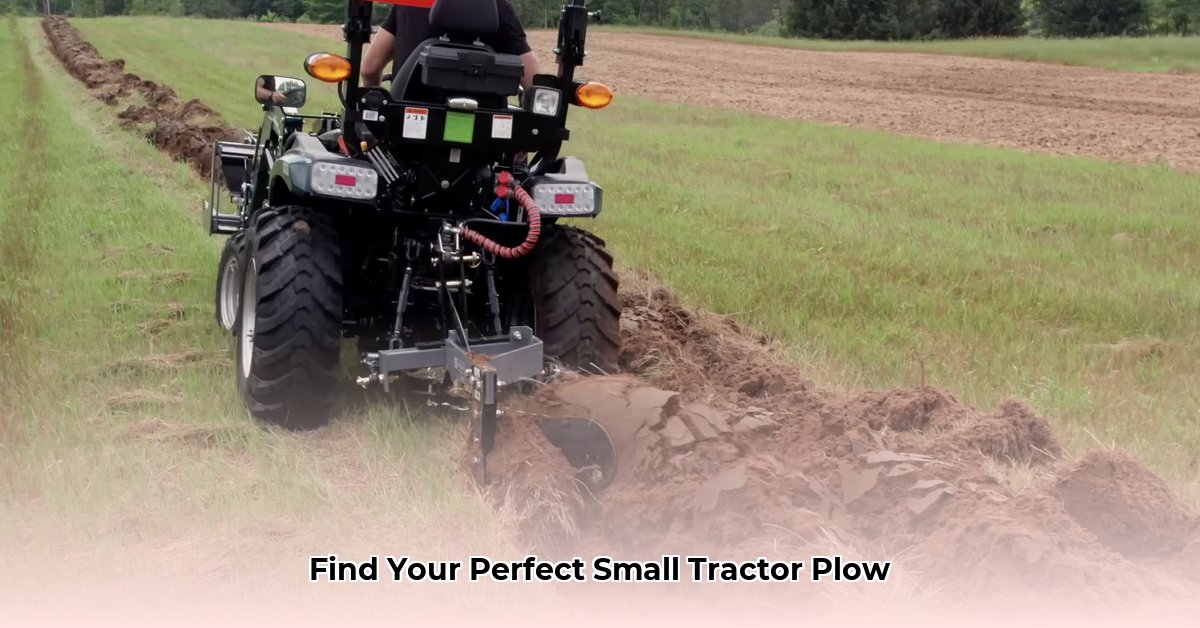
Choosing the right small tractor plow can significantly impact your land preparation efficiency and overall farming success. This guide provides a step-by-step approach to selecting the ideal plow for your specific needs, considering your tractor's capabilities, soil type, and the size of your property. Understanding these factors will ensure optimal performance and prevent costly equipment damage. For more plow options, check out this helpful resource.
Understanding Your Tractor's Capabilities
Before exploring plow types, meticulously review your tractor's owner's manual. Key specifications include:
Horsepower (hp): This indicates the engine's power output, directly influencing the plow's size you can handle. (The amount of power your tractor can generate.) A higher horsepower rating allows you to use larger and heavier plows.
Power Take-Off (PTO) Horsepower: This refers to the power transmitted from the tractor's engine to the plow's drive shaft. (The power specifically available to drive the plow.) Ensure your selected plow's PTO requirement aligns with your tractor's capacity.
Three-Point Hitch Capacity: This system connects the plow to the tractor. (The mechanism that attaches the plow to the tractor.) Verify that the plow's hitch matches your tractor's specifications for safe and efficient operation. Incorrect hitching can lead to serious damage.
Maximum Lift Capacity: The weight of the plow must be within your tractor's lifting capacity. (The maximum weight your tractor's hydraulic system can lift.) Overloading can damage your tractor's hydraulic system.
Ignoring these specifications can lead to tractor damage, reduced efficiency, and increased repair costs. Always prioritize safety and operate within your tractor's limitations.
Assessing Your Land and Soil Conditions
Your land and soil significantly influence plow selection. Consider these factors:
Property Size: Large fields might need wider plows for greater efficiency, while smaller plots benefit from maneuverable, narrower plows. (The area you need to plow directly affects the plow's width and the number of passes required.)
Soil Type: Heavy clay soils require more robust plows than lighter sandy soils. (Different soils require different tools for optimal tillage.) Clay soils need more powerful plows due to their density and resistance to plowing.
Plowing Depth: Deeper plowing generally requires more powerful tractors and heavier-duty plows. (The depth you plow impacts the required plow strength.) Consider the desired depth of soil turnover and adjust your plow selection accordingly.
Choosing the Right Plow Type
Several plow types cater to different needs and soil conditions:
Single-Bottom Plows: Ideal for smaller tractors and gardens, offering superior maneuverability in tight spaces. (A single-bottom plow tills a single furrow in each pass.) These are great for smaller properties or for maneuvering around obstacles.
Double-Bottom Plows: These significantly increase efficiency for larger areas but require more powerful tractors. (A double-bottom plow tills two furrows simultaneously.) These are more suited for larger fields but will overburden smaller tractors.
Moldboard Plows: The classic workhorse, excellent for deep tillage of heavy soils, but can be more aggressive and contribute to soil erosion. (These plows invert and completely turn the soil.) They provide thorough soil mixing but may not be ideal for all farming practices.
Chisel Plows: Less aggressive than moldboard plows, breaking up compacted soil without complete inversion, promoting better water infiltration. (They loosen and aerate the soil but don't completely invert it.) This method is often preferred for its conservation tillage benefits.
Subsoiler Plows: These focus purely on deep soil loosening to address compacted layers without affecting the surface soil. (They break up compacted subsoil to improve drainage and root growth.) These are useful for improving drainage without extensive surface disturbance.
Choosing the correct plow type is crucial for both efficient land preparation and soil health.
A Step-by-Step Guide to Plow Selection
This structured approach ensures compatibility and optimized performance:
Review Tractor Specifications: Confirm your tractor's horsepower, PTO horsepower, three-point hitch capacity, and maximum lift capacity. (This crucial step prevents overloading and damage.)
Assess Your Land: Determine your property size, soil type, and desired plowing depth. (A thorough assessment ensures compatibility between equipment and conditions.)
Select Plow Type: Choose a plow type based on your tractor's capabilities and soil conditions. (Consider the pros and cons of each plow type to make an informed decision.)
Confirm Compatibility: Ensure the plow's three-point hitch and PTO requirements match your tractor's specifications. (This step is vital for safe and efficient operation.)
Consider Additional Features: Adjustable depth settings, reversible plows, and other features can enhance versatility and efficiency. (These features can increase the plow's functionality and convenience.)
Maintenance for Optimal Performance
Regular maintenance significantly extends your plow's lifespan and enhances its efficiency. This includes:
Regular Sharpening of Plow Blades: Sharp blades provide cleaner cuts and prevent excess soil compaction. (Dull blades require more power and produce poor results.)
Inspection for Wear and Tear: Check for damaged or worn parts and replace them promptly. (Preventative maintenance avoids costly repairs and ensures safety.)
Lubrication of Moving Parts: Proper lubrication reduces friction and extends the life of moving components. (Regular lubrication is essential for smooth operation and longevity.)
By following this guide, you can select the optimal small tractor plow for your specific needs, ensuring efficiency, soil health, and longevity of your equipment.